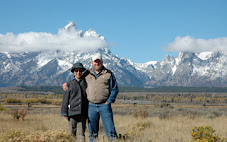Attending was free, but we had purchased tickets for access to the VIP tent. This meant that during the two hours between the jumping and cross-country skiing, we hung out in the tent and enjoyed breakfast, which was burritos, hot chocolate and fruit, followed by lunch, which was salad, chicken and corn taco soup and cookies. We also arrived pretty early and got what I think were the best seats in the bleachers for both the morning and afternoon events.
I have to say, this was a lot of fun, especially the race. Because everyone started based on their ski jump distance they were pretty spread out. The race course was 2km, so they made five loops to make 10km. This meant there was always a lot of action in front of us. Plus there were TV cameras along the trail and large monitors for the spectators.
In case you don't know, the Utah Olympic Park is near Kimball Junction, a few miles outside Park City.
Today the Park was groomed for ski jumping and cross-country skiing.
By 9 a.m. a pretty good-size crowd had gathered. We arrived about 30 or 45 minutes early and had out pick of spots in the bleachers.
The Nordic jump is the shorter hill on the left.
NBC Sports broadcast this event, so TV cameras and professional photographers were plentiful.
Prior to the competition, which included one practice jump and one jump that counted, several young "sport" jumpers came down the hill, as well as several athletes who will be competing tomorrow in jumping only (the combined event was just today).
Today was only men, but tomorrow will include women, who did some practice jumps today.
A skier leaves the pole and heads down the hill.
Preparing to jump.
The launch.
Gaining altitude.
The winds were a little tricky today. They were pretty strong at times, and near the knoll there was a tailwind, whereas down the hill farther it turned into a headwind. Headwinds are best because they provide lift for the jumpers and carry them farther down the hill.
Midflight.
Preparing to land.
The landing. This one is not one of the longest, probably in the 60-meter range.
The top red line is 90 meters, and the bottom red line is 100 meters. Only a couple of competitors made it past 90 meters, and none reached 100. I think about 92 was the longest.
After the landing.
At the bottom, near the crowd.
And the finish. Only one jumper fell during the day, and he was one of the sport jumpers, not a competitor.
It's now two hours later, and the skiers are ready to start the cross-country skiing. This is skate-style skiing. Skate style is pretty much what it sounds like. When I ski, I do classic style, which is when the skis move in parallel.
The start. These three jumped nearly the same distance and thus started the race very close to each other. Competitors often join up into groups and work together to beat the others in the race. They take turns drafting off each other much as they do in bicycle races, and then they race each other at the end.
A taste of the action.
Bryan Fletcher is Number 5, which means after the ski jump he was fifth out of the nine, so he didn't jump far. He also started out fifth in the race. But here he has passed Number 2, Adam Loomis. Of the nine, there were two Fletcher brothers and two Loomis brothers. Bryan Fletcher, at 31, is the older of the two Fletchers. The younger Fletcher, Taylor, was favored to win today, but he didn't jump well and was only able to move up to fourth place in the skiing competition.
Bryan Fletcher was working with the Loomis brother, but on the fourth loop he took off out ahead on his own. Ben Loomis was Number 1 after the jump and led strongly over the first two loops of the Nordic race.
Bryan Fletcher is coming in for the finish on the fifth loop.
At the finish line.
Anyone who doesn't collapse at the end hasn't given enough. Even the last guy, who trailed the others by quite a bit, barely made it over the finish line when he tumbled over.
There seemed to be a lot of camaraderie among the competitors.
The winners: First-Bryan Fletcher, Second-Adam Loomis, Third-Ben Loomis.





















































